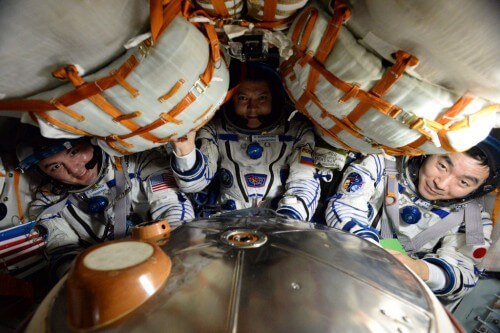Team members Kyle Lingren of the United States, Oleg Kononenko of Russia and Kimaya Yue of the Japanese Space Agency spent 141 days in space. On December 15, a Soyuz spacecraft will take off with three new crew members

The three members of the 45th crew of the International Space Station landed yesterday at 13:12 Israel time in a Soyuz spacecraft. In Kazakhstan it was already 19:12. They made a little history, this is the first landing of a Soyuz spacecraft in the hours of darkness (According to the NASA website).
The three, American Kyle Lingren, Oleg Kononenko of Russia and Kimaya Yue of the Japanese Space Agency spent 141 days aboard the International Space Station. For Lingergren and Yui this is the first flight, Kononenko has accumulated 533 space days.
At the station, the crew members participated in observations of the Earth and conducted research and experiments in the fields of physics and life sciences. The space station is an experimental field designed to demonstrate new technologies. Lindgren and Huey took part in the Veggie plant growing experiment that yielded fresh lettuce that the crew ate in August. When the technology demonstrated in the Veggie experiment is cooked, it will be possible to provide sustainable food to deep space travelers - something that is especially critical in the journey to Mars.
The astronauts will be able to use their platform for gardening activities in their spare time. The insights gained from the experiment may also improve the process of growth and biomass production on Earth, so that every person will benefit from it.
Another important study carried out by the 45th team is the continued stay of two team members - Scott Kelly from NASA and Mikhail Kornienko from the Russian Space Agency in order to gain insights into the management of human health during a long journey in space. The two still stay at the station as part of the 46th team.
The crew members also received three cargo spaceships - the Japanese HTV - the fifth in number that brought supplies to the station in August, the Russian Progress that arrived in October, and just a few days ago on December 9, 2015, Lingergren led the process of connecting the Cygnus spacecraft of Orbital ATK to the station (see "The supply spacecraft Cygnus returns to the space station, this time on a replacement rocket). This is the fourth Orbital spacecraft to arrive at the space station with supplies, when about a year ago the Antares launcher exploded with a Cygnus spacecraft on it, this time Orbital personnel used the ULA (United Launch Services) Delta 5 launcher.
During his stay on the station, Lindergren went on two preparatory spacewalks. The first included maintenance tasks - as well as transporting routing cables in preparation for the construction of a new docking station. In their second crime, he handled the ammonia cooling system.
Scott Kelly, one of the two astronauts who are scheduled to spend a year in space, was given command of the 46th crew, along with Kornienko and Sergey Volkov, both Russians. This time they will stay in the reduced format for only four days, on December 15 they are supposed to be joined by the American Tim Kopera, the European Tim Peek and the Russian Yuri Malenchenko.

One response
My Father Tikkun 141 days and spent days in space